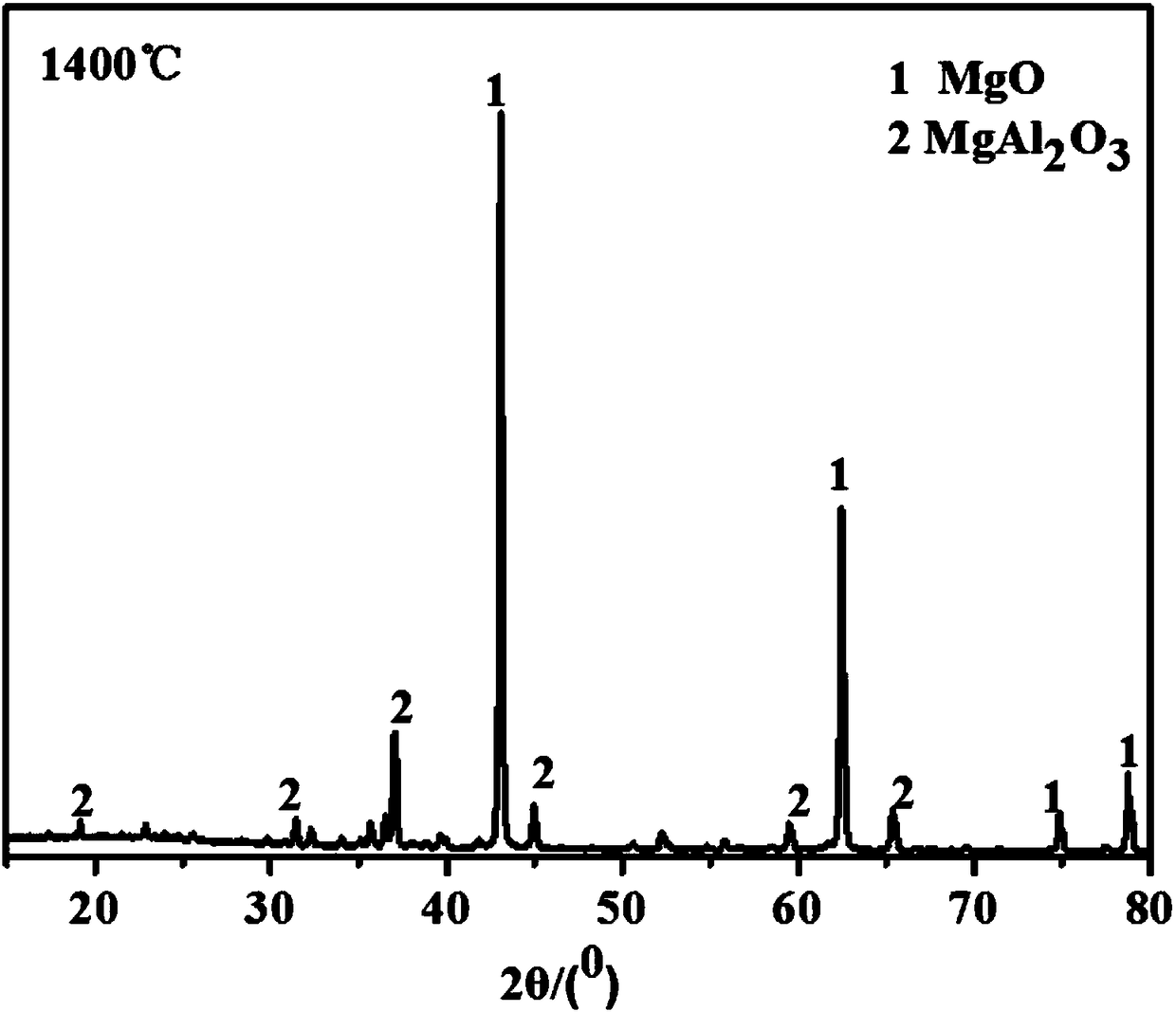Magnesium aluminate spinel enhanced magnesia-based foamed ceramic filter and preparation method thereof
A magnesia-aluminum spinel, foam ceramic technology, applied in magnesia-aluminum spinel reinforced magnesia-based foam ceramic filter and its preparation, filtration and purification of aluminum and its alloy melt, magnesia-based foam ceramic filter and In the field of its preparation, it can solve the problems of increasing matrix magnesium oxide lattice distortion, operation limitation, myocardial toxicity, etc., and achieve the effects of excellent chemical stability, good strength and simple process.
- Summary
- Abstract
- Description
- Claims
- Application Information
AI Technical Summary
Problems solved by technology
Method used
Image
Examples
Embodiment 1
[0050] According to the proportion that nano-alumina accounts for 4% of the mass of ceramic powder, weigh nano-γ-Al with a particle size of 30nm 2 o 3 The powder and particle size are 250 mesh (diameter d 50 Prepare ceramic powder for 58 μm) fused magnesia powder; mix and prepare rheological agent according to the mass ratio of polyvinyl alcohol and methyl cellulose at a ratio of 2:3.
[0051] According to mass percentage, 10% of nano-alumina sol with a solid content of 20% (select a commercial nano-alumina sol with a near-neutral pH value, the same below), 0.8% of rheological agent, and the rest are ceramic powders for batching. First, add magnesium oxide powder into the ball mill tank according to the proportion, prepare nano-aluminum sol, rheological agent and appropriate amount of deionized water (the amount to be added is determined according to the solid content of the ceramic slurry, the same below) to prepare a solution, and then add nano- γ-Al 2 o 3 Powder, sonica...
Embodiment 2
[0055] According to the proportion that nano-alumina accounts for 8% of the mass of ceramic powder, weigh nano-γ-Al with a particle size of 60nm 2 o 3 The powder and particle size are 500 mesh (diameter d 50 Prepare ceramic powder for fused magnesia powder (25 μm); mix and prepare rheological agent according to the mass ratio of polyvinyl alcohol and hydroxypropyl methylcellulose at a ratio of 2:3.
[0056] According to mass percentage, 15% of nano-alumina sol with a solid content of 25%, 1.5% of rheological agent, and the rest are ceramic powder for batching. First, add magnesium oxide powder into the ball mill tank according to the proportion, prepare nano-aluminum sol, rheological agent and appropriate amount of deionized water into a solution, and then add nano-γ-Al 2 o 3 Powder, sonicated for 45 minutes to make nanometer γ-Al 2 o 3After the powder is fully dispersed in the solution, add it to the ball mill tank, then add corundum balls according to the ratio of ball ...
Embodiment 3
[0060] According to the ratio that nano-alumina accounts for 6% of the mass of ceramic powder, weigh nano-γ-Al with a particle size of 50nm 2 o 3 The powder and particle size are 325 mesh (diameter d 50 Prepare ceramic powder for fused magnesia powder (45 μm); mix and prepare rheological agent according to the mass ratio of polyvinyl alcohol and hydroxyethyl cellulose at a ratio of 2:3.
[0061] According to mass percentage, 20% of nano-alumina sol with a solid content of 22%, 1.0% of rheological agent, and the rest are ceramic powder for batching. First, add magnesium oxide powder into the ball mill tank according to the proportion, prepare nano-aluminum sol, rheological agent and appropriate amount of deionized water into a solution, and then add nano-γ-Al 2 o 3 Powder, sonicated for 60 minutes to make nanometer γ-Al 2 o 3 After the powder is fully dispersed in the solution, add it to the ball mill tank, and then add corundum balls according to the ratio of ball to mate...
PUM
| Property | Measurement | Unit |
|---|---|---|
| particle size (mesh) | aaaaa | aaaaa |
| particle diameter | aaaaa | aaaaa |
| melting point | aaaaa | aaaaa |
Abstract
Description
Claims
Application Information
 Login to View More
Login to View More - R&D
- Intellectual Property
- Life Sciences
- Materials
- Tech Scout
- Unparalleled Data Quality
- Higher Quality Content
- 60% Fewer Hallucinations
Browse by: Latest US Patents, China's latest patents, Technical Efficacy Thesaurus, Application Domain, Technology Topic, Popular Technical Reports.
© 2025 PatSnap. All rights reserved.Legal|Privacy policy|Modern Slavery Act Transparency Statement|Sitemap|About US| Contact US: help@patsnap.com



